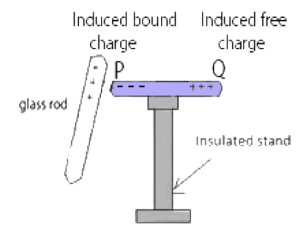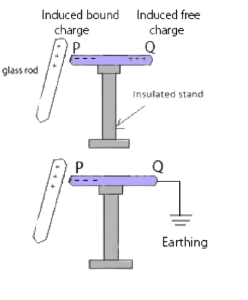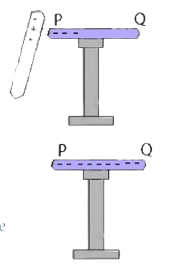Electrostatics :
Electrostatics is the branch of physics that deals with the study of charge at rest. Electrostatics is a branch of physics that studies slow-moving or stationary electric charges on macroscopic objects where quantum effects can be neglected. Under these circumstances the electric field, electric potential, and the charge density are related without complications from magnetic effects.
Electric Charge
Electric charge is the physical property of matter that causes it to experience a force when placed in an electromagnetic field. Or simply it is the property acquired by a body due to transfer of electrons from one to other. The SI unit of charge is coulomb (C).
There are two types of charges.
Positive Charge: A body is said to be positively charged if it has deficit of electrons in it.
Example: Protons have positive charge.
Negative Charge: A body is said to be negatively charged if it has the excess number of electrons in it.
Example: Electrons have negative charge.
Neutral charge: A body is said to be neutrally charged if it has equal number of positive and negative charges. For e.g. Neutrons have no charge – they are electrically neutral. The value of charge of an electron or the proton are same in magnitude and is given as
e = 1.6 × 10⁻¹⁹ C, which is basic electronic charge.
Properties of electric charges :
Like charges repel and unlike charges attract each other.
Quantization of charge:
Charge are quantized i.e. the total electric charge found on any charged body is an integral multiple of basic electronic charge.
i.e. q = ±ne Where, q = total charge, n=1, 2, 3, ……… is an integer, and e = 1.6 × 10⁻¹⁹ C.
- Total charge on a body is algebraic sum of all the charges present over the body.
- The charge is a scalar quantity.
- Charge cannot be created or destroyed but it moves from one place to another. The total charge of a system always remains constant. This property of charge is called the conservation of charge.
Q.1) Calculate the number of electrons present in 1 C of charge?
Given:
Charge (q) = 1 C
e=1.6×10−19 C
n=?
We know,

Charging a body Positively by method of induction :
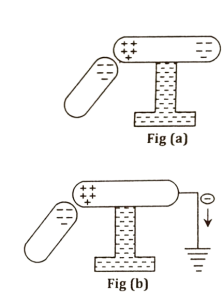
- Negatively charged ebonite rod is taken near to the conductor where positive charge is developed at nearer end and negative charge is induced at far end.
- The negative charges are earthed.
Conductors:
The substances which allows the charge to pass through it easily is called conductor. For e.g. copper, metal, mercury, human body etc. These can be charged by friction but the charges they gain do not remain localized and spread over the whole surface.
Insulators:
The substances which does not allow the charge to pass through it easily is called insulator. For e.g. glass, rubber, plastic, silk etc. These can be charged by friction but the charges cannot move to other parts and remain localized.
Note: Charges always spread out over the outer surface of conductor and do not reside in the interior of conductor because the similar charge always repel each other and due to repulsion they want to go away and away.
Surface charge density (σ):
It is defined as of charge per unit surface area of the conductor. If ‘q’ be the charge distributed on surface area ‘A’ of the conductor, then
It is given by relation, σ = q / A
Its SI unit is Coulomb per square meter (C·m⁻²).
The charge density depends on the curvature of the surface. The greater the curvature at any point, the greater will be the accumulation of charge at that point.
The surface charge density is very high at sharp edges or pointed ends of conductors. As shown in figure, the surface charge density of spherical conductor is symmetrically distributed where as for rectangular and conical body it is high at corners and pointed ends.
Note: Since,
A = 4πr² , ⇒ σ = q / 4πr²
or, σ ∝ 1 / r²
Note: For uniform shaped body, distribution of charge is uniform but for other shaped body the distribution of charge is inversely proportional to the radii of curvature of the surfaces. So the surface charge density is maximum at the pointed ends of a conductor.
Linear charge density (λ):
It is defined as of charge per unit length of the conductor. Its SI unit is C/m. It is given by relation, λ = q / l Where ‘l’ is the length of the conductor.
Volume charge density (ρ):
It is defined as of charge per unit volume of the conductor. Its SI unit is C/m³. It is given by relation, ρ = q / V Where ‘V’ is the volume of the conductor.
Action of points :
The surface charge density is very high at sharp edges or pointed ends of conductors. When air molecules come into contact at such pointed ends, they get similar charge and are repelled and move away. This process continues with new molecules and there rises a current of charged air called electric wind.
Due to the air molecules getting charged, the conductor looses charge. This action of loosing charge through pointed ends is known as action of points.
Applications :
- The action of points is used in lightning conductors. Lightning conductors with the sharp pointed ends are fitted at the top of the building in order to have a safe discharge of electricity generated in the atmosphere.
- The electric poles supporting the high voltage transmission lines are fitted with pointed conductors at the top. If there is any leakage of charge from the transmission lines to the poles it is discharged through the pointed ends.
Short questions:
1) A charged conical conductor loses its charge earlier than a similarly charged sphere. Why?
Ans: Conical conductor has less radius of curvature than a similarly charged sphere. So surface charge density (σ) is maximum at conical portion of a charged conical conductor (i.e. σ ∝ 1/r²). Due to action of points, the surface loses its charge earlier if its charge density is higher than the surface whose charge density is low. Due to this reason a charged conical conductor loses its charge earlier than a similarly charged sphere.
2) Why pointed ends are not kept in electrostatic machine?
Ans: We know that surface density of charge is maximum at pointed ends, so due to action of points the possibility of leakage of charge from the pointed ends is more, so that the machine does not perform well. That’s why pointed ends are avoided in electrostatic machine to prevent the leakage of charge from the machine to the surroundings.
3) A comb rub through dry hair attracts bits of paper. Why? What happen if the hair is wet or if it is rainy day?
Ans: When a comb rubs through dry hair, it gets charged either positively or negatively depending on the material of the comb. When it is brought near bits of paper, particles (atom) of the paper gets polarized and a net attractive force is developed, then attracts bit of paper.
If the hair is wet, friction between comb and hair is greatly reduced. Consequently the comb is charged to a lesser extent and it may not attract the small bits of paper. The same is true if it is a rainy day, because of higher humidity the hair does not remain perfectly dry.
4) An iron chains touching the ground are suspended from a vehicle carrying inflammable materials. Why?
Ans: As a vehicle moves on a road, due to air friction body of vehicle also gets charged in addition to charge developed on tyres. If the accumulated charge becomes excessive, sparking may occur and the inflammable materials may catch fire due to which explosion may occur. When an iron chain is suspended from vehicle to the ground, the electric charge accumulated on the body of vehicle flows to the earth’s surface through the chains. Hence the damage of fire is avoided.
Electric Force
The force of attraction or repulsion between any two charged bodies separated by a distance is known as electric force.
Coulomb’s Law
According to Coulomb’s law the electrostatic force between any two charged bodies q₁ and q₂ separated by a distance ‘r’ is,
- Directly proportional to the product of the magnitude of the charges of the two bodies.
F ∝ q₁ q₂……………….1 - Inversely proportional to the square of the distance between the two bodies.
F ∝ 1/r²……………………2
Combining the above equations,


Direction of coulomb’s force:
The direction of Coulomb’s force is always along the line joining two charges.
From figure, we can see that the direction of force exerted by q2 on q1q1 i.e. F12 is opposite to the force exerted by q1 on q2 i.e. F21. So, we can write,

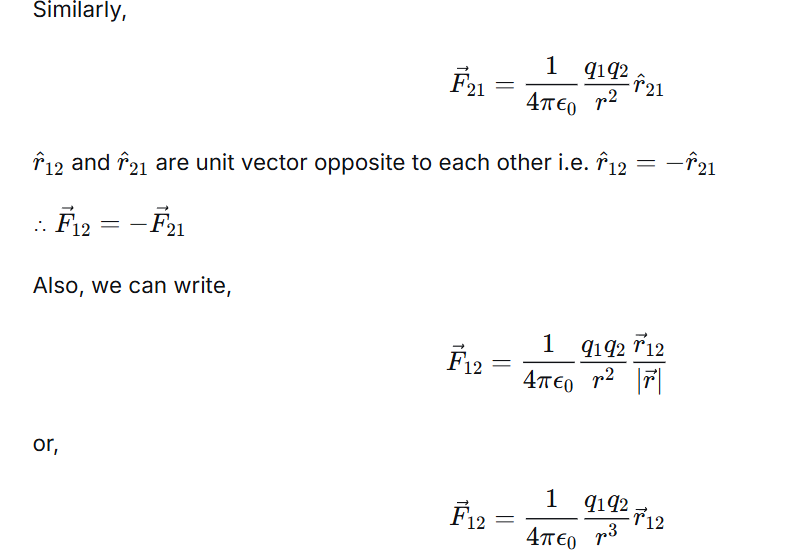
Permittivity
Permittivity is a characteristic of a medium between two charges which affect the force between two charges. Higher the permittivity less will be the force between charges and vice versa. So permittivity of the medium reduces the effect of force between two charges.
For e.g. Water has permittivity 80 times more than that of vacuum. This means if two charges are placed at a certain distance in water, the electrostatic force between the charges is 80 times less than the force between them when they are placed at the same distance in vacuum.
Relative permittivity (Dielectric constant):
Any insulating medium like paper, wax, mica, glass etc. is called a dielectric. The dielectrics have no free electrons in them like metals.
The relative permittivity of a medium is defined as the ratio of permittivity of any medium (absolute permittivity) to the permittivity of vacuum or free space.
i.e.

Where ‘εr‘ is the relative permittivity, ‘ε‘ is the permittivity of the medium and ‘ε0‘ is the permittivity of free space. Relative permittivity is also called as dielectric constant denoted by ‘K’. So, we can also write,

Now, let us consider two charges ′q1′ and ′q2′ are placed at distance r in a medium. Then the electrostatic force between the two charges is given by,

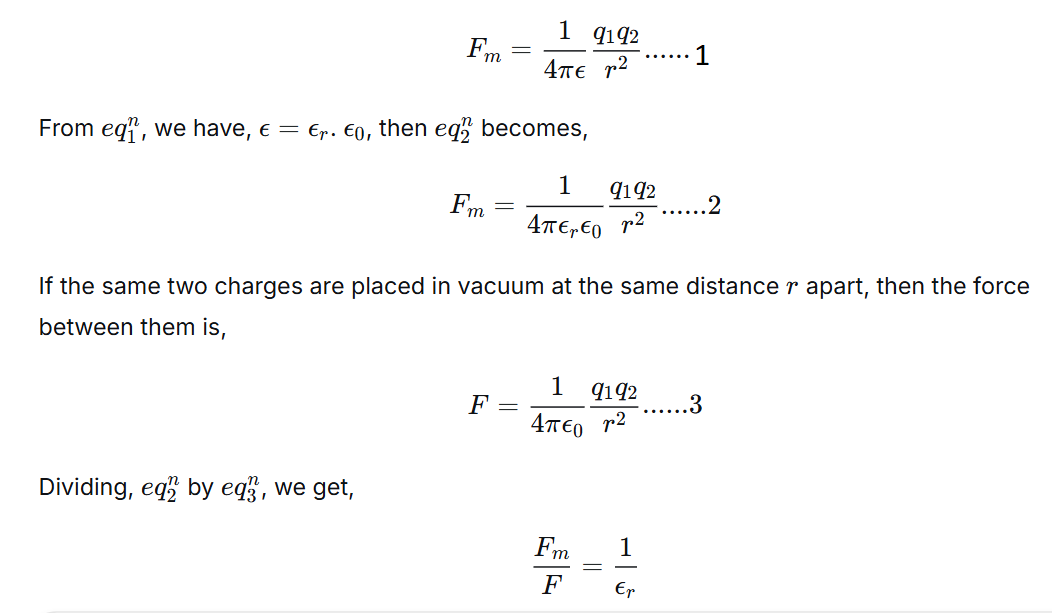
Thus, the dielectric constant (or relative permittivity) of a medium can also be defined as the ratio of the electrostatic force of attraction or repulsion between two charges placed at a distance in vacuum to that between the same charges placed at the same distance in the medium.


Force between multiple electric charges:
When there are large numbers of electric charges in a space or medium, each charge experiences Coulomb force due to other charges. Hence, the total force acting on a charge is the vector sum of forces on that charge due to all other charges. (This is the principle of superposition.)
If q1,q2,,…, qn are n number of point charges at different points in space and r12,r13,r14, be the distance of q1 from q2,q3, then the total force on q1 due to all other charges is given by,

Remember:
- The electrostatic force between any two charges is not affected by the presence of other charges. But the force on a single charge may change due to the presence of other charges around it.
- Coulomb’s law is only valid for point charges.
Numerical
Calculate the value of two equal charges if they repel one another with a force of 0.1 N when situated 50 cm apart in vacuum. What would be the distance between them if they are placed in an insulating medium of dielectric constant 10? solve it
solution:
Force: F=0.1 N
Distance: r=0.5 m
Coulomb’s constant: k=8.99×109Nm2/C2
The two charges are equal, so q1=q2=q


Determine the force of electrostatic interaction between the electron and the nucleus in a hydrogen atom.The mean distance of the electron from the nucleus is r=1×10−10 m.
solution:
r=1×10−10 m.
q1=q2=e=1.6×10−19 C
k=9×109 Nm2/C2

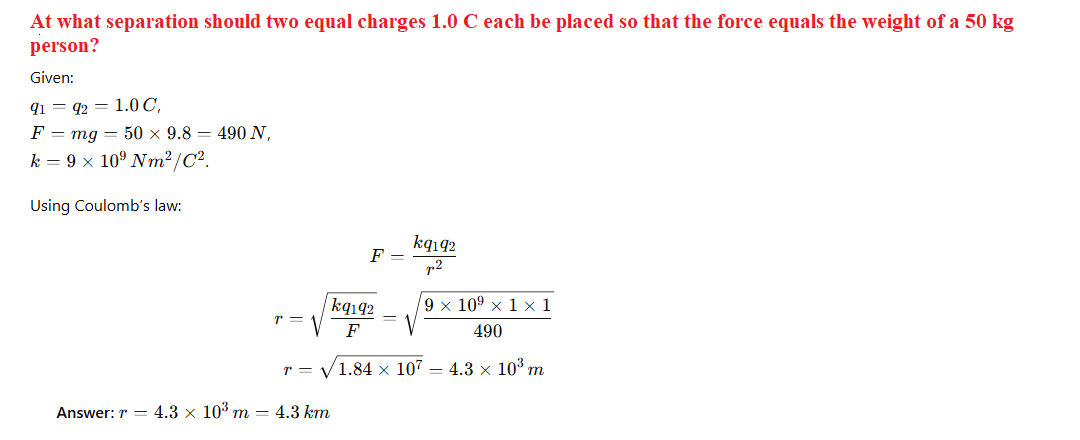
An average human weighs about 650 N. If two such generic humans each carried 1.0 C of excess charge, one positive and one negative, how far apart would they have to be for the electric attraction between them to equal their 650 N weight? Ans: 3721 m

What happen to the electric force between two charged bodies if the respective magnitude of charges are doubled and the distance halved?

A force acts between charges in vacuum. If a glass plate of dielectric constant K=6 is placed between them, find the new force.
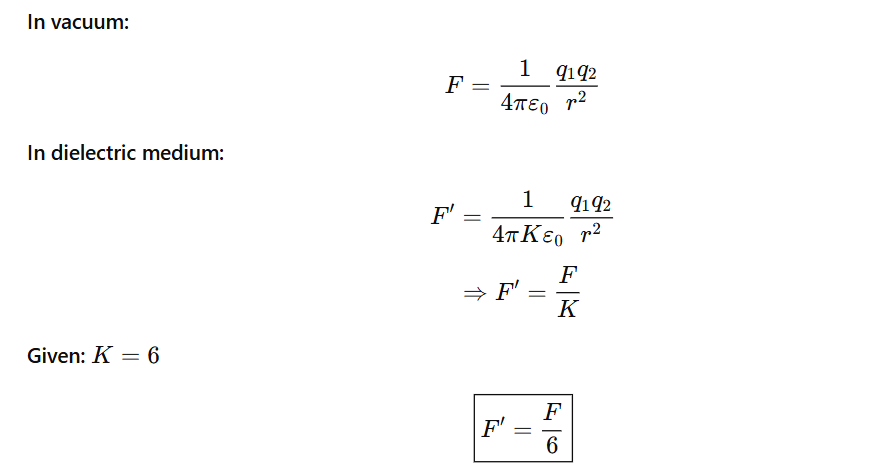
NOTE:
- ⇒ The Null point (Neutral point) is that point where any charge placed will experience zero force.
- ⇒ If both charge is of same nature (i.e. either both are positive or negative) then null point should be between the line joining two charges and
- ⇒ if both charge is of opposite nature then null point should be outside the line joining two charges.
- ⇒ The null point is always near to the magnitude of smaller charges.
Electric field :
The space around a charge where its effect (force of attraction or repulsion) can be experienced is called electric field. The effect may be strong or weak. We call it intensity of electric field. The measurement of the electric field at a point in space around a charge is given by electric field intensity.
Electric field intensity (E):
Electric field intensity at a point in an electric field is defined as the force experienced by a unit positive charge placed at that point.
If ‘F’ is the force experienced by the unit positive test charge ‘q₀’ at a point in an electric field, then the electric field intensity is given by,

It is a vector quantity and its direction is the direction along which the positive charge tends to or would move. Its SI unit is N C⁻¹.
Electric field intensity due to a point charge:

Consider a point charge +q at a point O in the space. Suppose a test charge +q₀ is placed at point P at a distance ‘r’ from point O.The force experienced by the test charge +q₀ is,

Electric field lines (Electric lines of force):
The field around a charge or group of charges is represented by lines (straight or curved) called the electric field lines. It is also the imaginary lines or curves in which the tangent drawn at any point on it gives the direction of the electric field at that point.
Properties of Electric field lines:
- Electric field lines due to positive charge are always directed radially away from the charge and of negative charge is towards the charge.
- Electric field lines start from positive charge and end at negative charge. If there is a single charge, they may start or end at infinity.
- Electric field lines are continuous curves without break at any point.
- A unit positive charge placed in the electric field lines tends to follow the path along the field lines if it is free to do so.
Compiled By: Er. Basant Kumar Yadav



